
You are using an out of date browser. It may not display this or other websites correctly.
You should upgrade or use an alternative browser.
You should upgrade or use an alternative browser.
Brian May pickups and wiring question(s)
- Thread starter briny001
- Start date
Superbeast520
Hero Member
- Messages
- 617
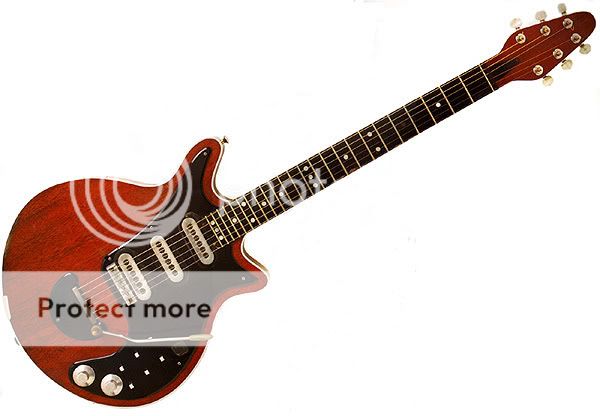
Here ya go Brian May's wiring diagram......hope its helpfull...
http://www.guitartechcraig.com/...... Got that info here...
http://www.guitartechcraig.com/techwire/brianmay.jpg Brian May's Red Special
http://i90.photobucket.com/albums/k278/theoneandonlymechris/brianmay.jpg[/IMG]]
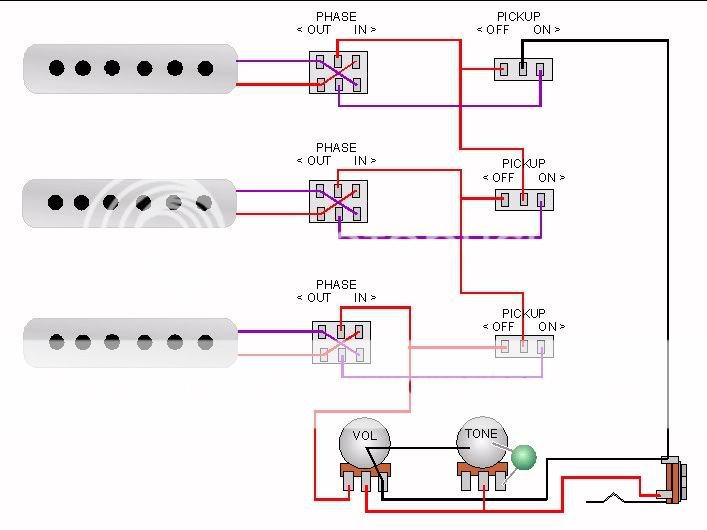
http://www.brianmaycentral.net/main.html Brian May Central home page
http://www.brianmaycentral.net/kzreview.html Brian May Central
The On/Off and Phase reversal switches are white Switchcraft types. They are fitted to a plate beneath the scratchplate, as are the volume and tone potentiometers. This replicates the original guitar design. Unlike the Guild and Burns replicas there are no screws visible on the scratchplate to hold them in position.
http://www.squidoo.com/redspecial detailed info on the "Red Special" guitar
First, the coils were potted in Araldite epoxy to help reduce their microphonic tendencies. Next the pickups were
direct mounted to the body, and after much experimentation the pair eventually settled on an arrangement where
each pickup passed to two small 2-position slider switches, the first row, nearest the pickups, being on/offs for each
pickup and the second row allowing phase reversal for each. These switches and the volume and tone pots were all
mounted on a shielding-aiding aluminium plate underneath the black perspex scratchplate.
This wiring allowed a number of different pickup configuations and tones. With two or more pickups on together the
sound combined in series - not parallel, as on a Strat, for instance - increasing the output and giving the guitar its
famously fat, resonant humbucking tone when combined with a treble booster into a Vox AC30. But when May
flicked up one of the phase reversal switches it cancelled out the low end harmonic, creating a chiming clean tone or
the trademark sreeching lead sounds typified by the Bohemiam Rhapsody solo (neck and middle pickups on
together, out of phase).
http://www.brianmaycentral.net/phasing.html......The switching explained
The mysteries of pickup combinations!
"By Matthew Pickles"
--------------------------------------------------------------------------------
Brian May guitars virtually always feature the same unique pickup switching system Brian uses on the Old Lady herself. For some reason, Burns don't bother to give you a manual if you buy one of their otherwise excellent guitars, so here is the BrianMayCentral guide to the mysteries of the Brian May pickup switching system!
Rather than the standard 5-way or 3-way toggle switches on Fender and Gibson guitars, Brian May guitars feature 6 little individual switches. For each pickup there is an on-off switch and a phase reversal switch, which gives many more interesting possibilities in combining pickups. Brian May guitars are also wired in series rather than parallel, which also gives different tonal possibilities. So what do all those switches actually do?
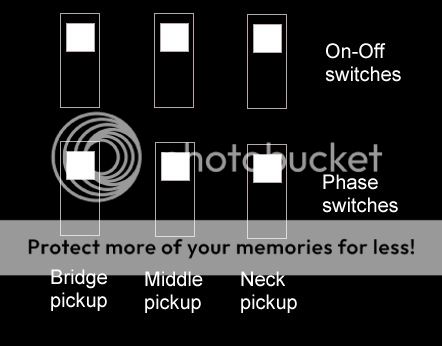
On-off switches
Let's start by just looking at the on-off switches - we'll worry about the phase switches later. Each pickup has its own switch, so it can be turned on or off independently of the others. This means that the guitar has a true 'standby' mode where all of the pickups are off. The three single coil pickups each produce slightly different tones due to their positioning. The bridge pickup is brightest and most trebley, the neck pickup is much warmer and more mellow and the middle pickup is between the two, both physically and tonally. Any combination of 1, 2 or all 3 pickups can be selected. Brian's favourite tone is the bridge and middle pickups both selected and in phase (more of that in a moment). Switching on all three pickups is also very interesting and gives a huge tone. Because the pickups are wired in series, selecting more than one pickup increases the output of the guitar and can therefore give you more gain.
Phase Switches
Now, let's have a look at those phase switches. These only apply if you have 2 or more pickups selected as one pickup alone can't be out of phase with itself. Phase is also relative, so it is the difference that matters. If that sounds too obscure, let me give you an example. Switch on both the bridge and middle pickups and put both of the phase switches in the down position (i.e. towards the floor). The sound will be Brian's favourite rhythm tone. Now flick the phase switch on the middle pickup to the up position. The sound will now be much thinner and more trebley as the lower frequencies cancel - the pickups are out of phase. Now flick the phase switch on the bridge pickup to the up position. The tone will be back to the full rhythm tone we had originally - i.e. it doesn't matter if you have the switches up or down, it's the difference in phase which matters. Now that we've got that cleared up, lets look at some of the possible combinations. Generally speaking, putting two pickups in phase will produce a full, rich tone and selecting two pickups out of phase will produce a piercing trebley tone. You can also get some really interesting combinations by putting all three pickups on but selecting one to be out of phase with the other two. There are a total of 13 possible combinations (there are actually 21 possibilities, but some are the same as each other because of the phase differences explained above). Let's look in detail at some of the tones to try...
Bridge and Middle pickups in phase
This is Brian's favourite pickup combination, which he uses 85% of the time. For chords and rhythm work this combination can give that lovely full ringing tone, but still maintains good separation between notes so it doesn't turn muddy. A good example of this tone are the riffs on Hammer to Fall and Tie Your Mother Down. This setting is also good for lead work and was used by Brian for the opening solo in Brighton Rock.
Neck and Middle pickups in phase
This is a very rich tone, which gives has an amazing violin-like quality if you back off the gain a little. Brian used this tone for the solo work on You Take My Breath Away and Leavin' Home Ain't Easy. For smooth solo sounds like this, Brian often uses his fingers to pick the strings rather than a sixpence and he gently strokes the strings to coax out those smooth rich sounds.
Neck and bridge pickups in phase
A cutting but rather sweet sound.
Neck and Bridge pickups out of phase
A strong bright lead tone. Brian used this on the solo work for Liar and for the riffs on Stone Cold Crazy.
Neck and Middle pickups out of phase
This is a real 'screaming' lead tone, which is piercing at high volumes. Brian used this tone extensively on songs where he wanted a really emotional cutting solo, such as Bohemian Rhapsody, Somebody to Love and The March of the Black Queen.
All 3 pickups selected with neck out of phase
This uses all three pickups and sounds a little bit like a Rickenbacker tone, or a harder version of Brian's favourite sound (mid + bridge in phase). Funky rhythms at low levels, hard and hollow at high levels.
All 3 pickups selected with bridge out of phase
A very rich sound at very high levels (Violin type tone)
All 3 pickups selected with middle out of phase
Brian calls this "Bread and butter" after that rhythm sound. Makes a strange clang on the low strings. Piercing at high levels.
Superbeast520
Hero Member
- Messages
- 617
Brian May wiring Mods.....
http://www.treblebooster.com/brian_may_pickup_mod.htm
Another Way to Wire the Red Special Guitar
Better? MAYbe. Get More Sounds with this Easy Mod
Copyright 2003 Scott Humphrey
www.treblebooster.com
How many sounds can you squeeze from your Brian May guitar?
Geeze, with all those switches you'd think that any pickup combination would be possible. Well, despite all those switches there are still a few combinations that are unobtainable on a stock Brian May guitar. Fortunately this is easily remedied. Presented here is an alternative way to wire the Brian May guitar.
This new wiring scheme will add a few new Strat-like sounds to your Brian May axe. By simply changing around a few wires you'll have access to eight new pickup combinations. As a bonus this modification is not permanent, you need only a soldering iron to do it, and you won't have to sacrifice any of the sounds that your guitar already has.
Do you ever get the urge to, you know, move over Rover, and let Jimi take over, but the Stratocaster sounds just aren't in in your Brian May guitar? Well, as Jimi Hendrix once said, "You know what I'm talkin' 'bout! Yeah, baby, get on with it!"
Click here to listen to listen to my Red Special set to one of the modified pickup combinations.
O.K., we'll get on with it, but first first a little background on the pickup configurations of the Stratocaster vs. the Brian May guitar. In the Stratocaster the pickups are wired in parallel (see Figure 1). Brian May, on the other hand, decided to wire his pickups in series (see Figure 2), which means that the output of one pickup is fed into the input of the next. Connecting pickups in parallel, like on a Stratocaster, allows the signal from each pickup to reach the amplifier by the shortest possible route. The result is that the high frequencies make it to the amplifier undisturbed, and this gives the Strat it's sparkling sound.
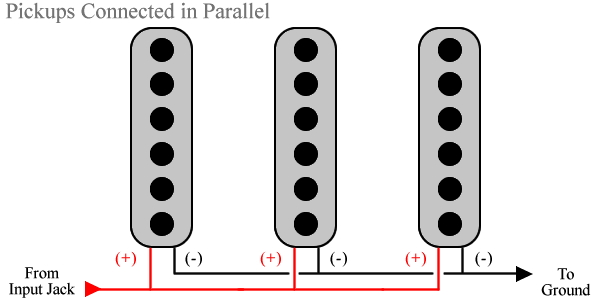
Figure 1: In this figure three pickups are wired in parallel (all of the pickup inputs are connected together, and all of the outputs are connected together). This often makes for a very bright tone.
When the pickups are wired in series, on the other hand, some of the treble frequencies are suppressed. Why? It's because a long wire (pickup wire in this case) acts like a resistor -- the longer the wire, the larger the resistance value. There are two things to keep in mind: 1) a resistor in the signal path will suppress the audio signal, and 2) higher frequencies are attenuated more by a resistor than lower frequencies are. (This occurs because high frequencies have less energy than the low frequencies. Have you ever noticed that when your stereo is playing in the next room you can hear the bass, but you can't hear the treble? The treble frequencies don't have enough energy to pass through the walls, but the bass frequencies do. Perhaps you've also noticed that when you use a long guitar cable the sound isn't as detailed as when you use a shorter cable: longer cable = more resistance!). Anyway, the point is that when pickups are wired in series some of the high frequencies are lost because the signal has to travel through twice as much pickup wire to reach the amplifier.
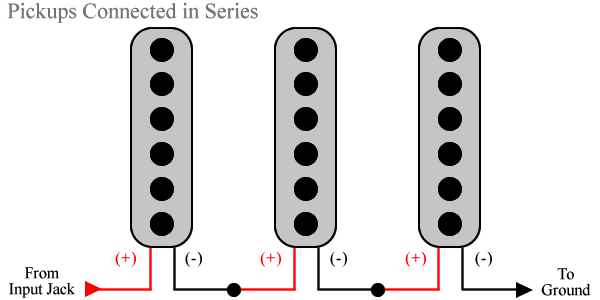
Figure 2: These three pickups are wired in series, meaning that the output of one is connected to the input of the next. This makes for a hot output at the expense of treble frequency loss.
The wiring method that Brian May came up with is really ingenious, because so many sounds are possible with his system. There are three Tri-Sonics single-coil pickups on the Brian May guitars by Guild or Burns. Each pickup has an on/off switch and an in-phase/out-of-phase switch, making for a total of six switches (see Figure 3). When two pickups are placed in series what results is a loud audio signal, assuming that the pickups are in-phase with each other. If you flip the phase switch of one of the pickups it causes the frequencies which are common to both pickups to cancel out. The sound doesn't cancel completely because each pickup amplifies different overtones due to it's physical position on the guitar.
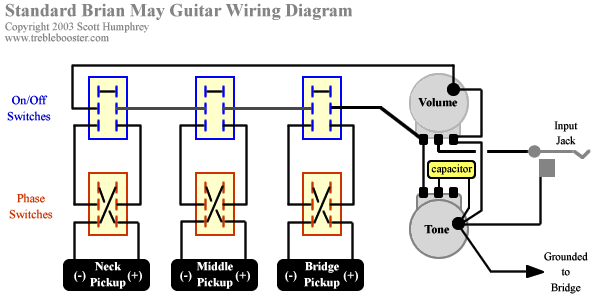
Figure 3: The Standard Wiring Diagram for the Brian May Guitar. Note that the pickups are connected in series, and that each pickup has a phase switch to reverse it's polarity. Note: although the phase switches on the Burns Brian May guitars are wired in a slightly different manner, they are equivalent electronically.
This wiring scheme can result in some interesting frequency responses, and it is partly responsible for Brian May's signature tone. Take a listen to the guitar solo on "Bohemian Rhapsody." That crying guitar tone is created by putting the neck and the middle pickups in series and out-of-phase (and then driving the hell out of the amplifier).
These six switches provide twenty-one possible pickup configurations. Wow! That's a lot! However, eight of those combinations are actually redundant, which leaves only thirteen real-world sounds (which is still a lot).
Why the redundancy? This is best explained with an example. Take, for instance, two guitar pickups that are in series and in phase with each other. Now switch pickup #1 to the out-of-phase position. If you play a chord and listen, the sound will be changed dramatically because some of the frequencies have been canceled out. Now switch the phase on pickup #2. The sound is now the same as it was before you moved any switches, even though both of the phase switches have been changed. This is because the two pickups are in phase with each other, even though they are 180 degrees out-of-phase from where they started before you began messing with the switches.
It is because of this redundancy that you don't actually need all three phase switches to achieve the stock Brian May guitar sounds. You actually only need need two of them. Why not, then, use that extra switch to alternate between series and parallel pickup switching? You can't live with a measly thirteen sounds can you? NO! More is better!
The New Sounds
By making a few simple changes based around the "extra" phase switch for the bridge pickup (see Figure 4), you can add eight more pickup combinations to the thirteen that you already had. You will then truly have twenty-one different sounds. (You'll have to figure out the math on your own).
Two of these are hum-cancelling pickup combinations that you won't have without making this modification. If you play a high gain amplifier you'll know how important it is to have a guitar that doesn't hum. You'll want the reverse wound pickup to be in the bridge position instead of in the middle position (this is important to maximize the number of humbucking settings!!!). This way the best pickup combinations cancel the hum and noise:
-bridge and middle pickups in series and in phase
-bridge and middle pickups in parallel and in phase
-bridge and neck pickups in series and in phase
-bridge and neck pickups in parallel and in phase
-middle and neck pickups in series and out of phase
That is five no-hum pickup combinations, which is more than any Strat or a Les Paul has!
Actually there is a SIXTH humbucking setting, which is a bit of a mystery to me (which is why I call it "the mystery setting"). When the modified switch for the bridge pickup is set to parallel, you can turn the other two pickups in phase and there won't be any hum. Basically, having the bridge pickup in parallel with the both the middle and neck pickups (which are in phase and in series with each other) seems to cancel the hum. I'm not sure why this works, since there all three pickups are turned on. If you figure it out please let me know.
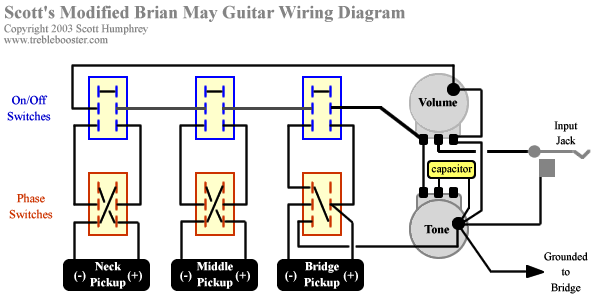
Figure 4: The Modified Wiring Diagram for the Brian May Guitar. Note that the wiring of the phase switch of the bridge pickup has been changed. This allows you to alternate between parallel and series pickup combinations. Note: although the phase switches on the Burns Brian May guitars are wired in a slightly different manner, they are equivalent electronically. To make this mod on a Burns guitar simply change the bridge pickup phase switch so that it appears as in the above diagram. Do not change the other two phase switches.
Once you have completed this modification you'll notice that (if you leave the phase switch of the bridge pickup in the up position) you can still get all of the stock Brian May sounds by simply using the three on/off switches and the other two phase switches in the normal fashion. When you click the altered switch of the bridge pickup to the down position, however, that pickup will now be in parallel with the other two pickups. You can then manipulate the on/off and phase switches of the middle and neck pickups to get the new, non-stock sounds.
If you try to play with the bridge pickup by itself and the altered switch is set for parallel pickup combinations, you will get no sound. THIS IS NORMAL! Don't panic! You just need to click the new modified switch to the series position (or you could just turn on one of the other pickups).
Putting the pickups in parallel really brings out some nice jangly sounds that weren't there with the stock wiring. Plugged into a clean amp the parallel pickup combinations really shine, and they do have a Strat-like quality to them. My favorite combination has the bridge and middle pickups in parallel and in-phase. This provides a great rhythm sound.
Another great Strat-like pickup combo involves having the bridge and neck pickups in parallel and in-phase. What is really cool is that with this setting you have a humbucking pickup combination with which you can turn off the sound with the single on/off switch for the neck pickup. This can be used for an effect that I'm sure you've heard before (click here and I'll do this for you).
About the only pickup combination that you can't obtain with this switching system is the middle and neck pickups in parallel and in phase (the Stratocaster/Jimi Hendrix Little Wing setting). However, having the bridge and neck pickups in parallel and in phase produces an equally cool but different sound, and you can't get that pickup combination on a stock Stratocaster!
I hope you'll enjoy the new sounds that you'll achieve with this modification. Now, get on with it, baby! Yeah!!!
Trying to achieve some Brian May guitar tones? A treble booster is an essential tool for obtaining "that sound."
************************************************************************************
Presented below are two new alternative wiring methods that can be used to achieve similar results, while at the same time keeping the function of the original switches intact. The switching systems below were developed in response to comments from Brian May about the above modification. These new switching systems both involve adding an extra switch to your guitar.
Apparently, Brian will sometimes change the phase switches to cause certain notes feed back differently. In other words, he will occasionally change the phase switches so that his guitar becomes 180 degrees out-of-phase in order to change the way the guitar reacts with the amplifier at higher volumes (even though the basic sound and pickup combination remains the same). Also, luthier Greg Fryer mentioned that it would be nice to keep the phase switches as they are in order to have the option of making sure that the guitar signal is electro-acoustically in phase with the amplifier/speaker. "Diagram 2" below shows a way to achieve the series/parallel pickup combinations as above without changing the current function of the switches.
Brian also thought it would be interesting to design a switching system that would allow a guitarist to change all three pickups from a series to a parallel configuration with a single flip of a switch. The "Super Cool, Yet Ridiculously Complicated, Modified Brian May Guitar Diagram" below shows how this can be done. The only catch is finding a switch that is tough enough to handle the abuse of a rock guitarist. An eight pole, double throw switch (8PDT) is necessary for this modification, but industrial strength versions of this type of switch may be difficult to find.
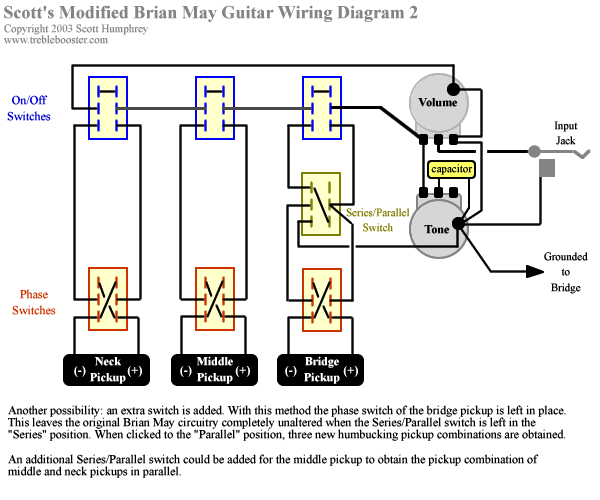
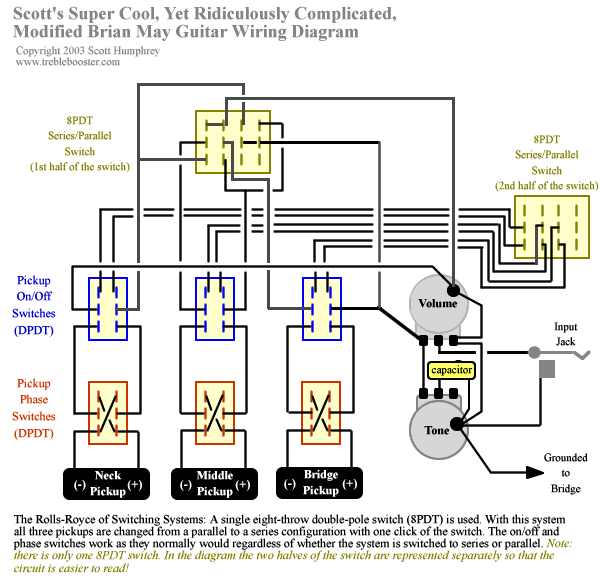
This diagram was sent to me by Maik Schrake of Germany. He was pondering the diagram above, and came up with a better solution for obtaining series/parallel combinations for the Brian May guitar. This is, in my opinion, the best way to wire the guitar. Thanks, Maik!
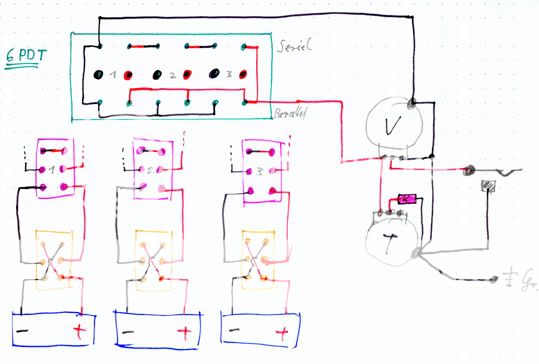
***********************************************************************************
Here are a few more circuits that were sent to me by guitarist Steven Bragg. I've included his text (in italic) that accompanies the diagrams below:
I have seen diagrams of the RS circuit that look basically like the one I've drawn in BurnsStock. There are two different ways to wire the phase switches, and I've seen drawings of both ways, but for the stock scheme the two are electrically equivalent. I don't know if the volume and tone circuits are wired exactly as I've shown them but if not, they should be. That's the scheme that gives the least interaction of tone and volume settings, and makes a bypass capacitor basically unnecessary. The crucial point is that the tone pot should get its signal from lug 2 (the center lug) of the volume pot, not from lug 3.
Anyway, that stock circuit was designed by a 16-year-old (although an unusually intelligent 16-year-old) and though it is logical from a signal path perspective, it is actually more complicated than it needs to be. I have drawn a simpler, less expensive, and easier to wire circuit that is electrically identical, in diagram BurnsSPST. This circuit uses a simpler and less expensive SPST on-off switch, and allows for a less convoluted wiring path. As both pickup leads are floating, this does not load the circuit when the switch is closed. If you're not used to tracing signals in a schematic, note that closing the switch in parallel with the pickup bypasses the coil, turning the pickup off. The stock wiring does the same thing, but in a more roundabout way. The sound is identical. Having the on-off precede the phase also simplifies the remainder of the wiring. The advantage of this circuit is that it preserves the stock appearance and 6-switch setup.
A further simplification, shown in diagram BurnsDPDTcb, takes advantage of the availability of a 3-position DPDT-center-both (on-on-on) switch. This allows a single switch to be used for both on-off and polarity reversal functions. Center position is "off" (signal passes straight through the switch, bypassing the coil) and each throw is on, but of opposite polarity (phase). This eliminates the need for three of the switches, yet offers exactly the same pickup switching and phase combinations as the stock scheme. Note that the center lug must be wired to the output, not the pickup. Unlike the stock wiring, the two choices are not equivalent in this scheme. I have wired my own guitar, a strat copy, exactly this way, and it absolutely nails the tones of the RS, though it no longer sounds strat-like except when only one pickup is on. This circuit is ideal if you are building a guitar from scratch, or modifying another 3-pickup guitar as I did. I used minitoggle switches; I don't know if you can get a DPDT-center-both as a slider or not. I prefer the toggles anyway.
The previous examples offer simplified operation and easier assembly. The schematic shown in diagram Burns4PDT shows a more complex design, but one which is very versatile, perhaps allowing a guitarist playing a wide variety of styles to use a single guitar for all of them. In addition to all of the normal RS series sounds, it can also give all the normal Fender parallel sounds, but can also add parallel combinations not found on a stock strat, such as neck and bridge pickup on together, or all three, or true phase reversal of any or all pickups, etc. Unfortunately I can't find a way to do this without going back to the six switch setup for switching and phase. But you can use a simple SPDT for the on-off switches, which does simplify life a little. If you're modifying an existing RS, you can ignore 3 of the lugs on each DPDT on-off switch; you don't have to buy a new SPDT switch. You'll need a 4PDT switch to select the series (RS) or parallel (Fender, Gibson, etc) mode. An advantage of this scheme, compared to others that I've seen, is that the regular six switches work in exactly their usual way, no matter how you set the mode selector. There are no sounds or combinations you have to give up, and no oddball switch arrangements to remember. When I eventually acquire a RS, this is how I will wire it. I'll convert the volume and tone controls to concentric single-hole dual control, and put the series/parallel switch in the other hole.
A very important caveat: although I designed this 4PDT circuit, I have not built/tested it yet. It certainly looks like it should work, but I can't be 100% sure until somebody, perhaps one of you, wires it up and tries it. The DPDTcb circuit does indeed work in my guitar, but the 4PDT circuit should be considered experimental until proven.
http://www.treblebooster.com/brian_may_pickup_mod.htm
Another Way to Wire the Red Special Guitar
Better? MAYbe. Get More Sounds with this Easy Mod
Copyright 2003 Scott Humphrey
www.treblebooster.com
How many sounds can you squeeze from your Brian May guitar?
Geeze, with all those switches you'd think that any pickup combination would be possible. Well, despite all those switches there are still a few combinations that are unobtainable on a stock Brian May guitar. Fortunately this is easily remedied. Presented here is an alternative way to wire the Brian May guitar.
This new wiring scheme will add a few new Strat-like sounds to your Brian May axe. By simply changing around a few wires you'll have access to eight new pickup combinations. As a bonus this modification is not permanent, you need only a soldering iron to do it, and you won't have to sacrifice any of the sounds that your guitar already has.
Do you ever get the urge to, you know, move over Rover, and let Jimi take over, but the Stratocaster sounds just aren't in in your Brian May guitar? Well, as Jimi Hendrix once said, "You know what I'm talkin' 'bout! Yeah, baby, get on with it!"
Click here to listen to listen to my Red Special set to one of the modified pickup combinations.
O.K., we'll get on with it, but first first a little background on the pickup configurations of the Stratocaster vs. the Brian May guitar. In the Stratocaster the pickups are wired in parallel (see Figure 1). Brian May, on the other hand, decided to wire his pickups in series (see Figure 2), which means that the output of one pickup is fed into the input of the next. Connecting pickups in parallel, like on a Stratocaster, allows the signal from each pickup to reach the amplifier by the shortest possible route. The result is that the high frequencies make it to the amplifier undisturbed, and this gives the Strat it's sparkling sound.

Figure 1: In this figure three pickups are wired in parallel (all of the pickup inputs are connected together, and all of the outputs are connected together). This often makes for a very bright tone.
When the pickups are wired in series, on the other hand, some of the treble frequencies are suppressed. Why? It's because a long wire (pickup wire in this case) acts like a resistor -- the longer the wire, the larger the resistance value. There are two things to keep in mind: 1) a resistor in the signal path will suppress the audio signal, and 2) higher frequencies are attenuated more by a resistor than lower frequencies are. (This occurs because high frequencies have less energy than the low frequencies. Have you ever noticed that when your stereo is playing in the next room you can hear the bass, but you can't hear the treble? The treble frequencies don't have enough energy to pass through the walls, but the bass frequencies do. Perhaps you've also noticed that when you use a long guitar cable the sound isn't as detailed as when you use a shorter cable: longer cable = more resistance!). Anyway, the point is that when pickups are wired in series some of the high frequencies are lost because the signal has to travel through twice as much pickup wire to reach the amplifier.

Figure 2: These three pickups are wired in series, meaning that the output of one is connected to the input of the next. This makes for a hot output at the expense of treble frequency loss.
The wiring method that Brian May came up with is really ingenious, because so many sounds are possible with his system. There are three Tri-Sonics single-coil pickups on the Brian May guitars by Guild or Burns. Each pickup has an on/off switch and an in-phase/out-of-phase switch, making for a total of six switches (see Figure 3). When two pickups are placed in series what results is a loud audio signal, assuming that the pickups are in-phase with each other. If you flip the phase switch of one of the pickups it causes the frequencies which are common to both pickups to cancel out. The sound doesn't cancel completely because each pickup amplifies different overtones due to it's physical position on the guitar.

Figure 3: The Standard Wiring Diagram for the Brian May Guitar. Note that the pickups are connected in series, and that each pickup has a phase switch to reverse it's polarity. Note: although the phase switches on the Burns Brian May guitars are wired in a slightly different manner, they are equivalent electronically.
This wiring scheme can result in some interesting frequency responses, and it is partly responsible for Brian May's signature tone. Take a listen to the guitar solo on "Bohemian Rhapsody." That crying guitar tone is created by putting the neck and the middle pickups in series and out-of-phase (and then driving the hell out of the amplifier).
These six switches provide twenty-one possible pickup configurations. Wow! That's a lot! However, eight of those combinations are actually redundant, which leaves only thirteen real-world sounds (which is still a lot).
Why the redundancy? This is best explained with an example. Take, for instance, two guitar pickups that are in series and in phase with each other. Now switch pickup #1 to the out-of-phase position. If you play a chord and listen, the sound will be changed dramatically because some of the frequencies have been canceled out. Now switch the phase on pickup #2. The sound is now the same as it was before you moved any switches, even though both of the phase switches have been changed. This is because the two pickups are in phase with each other, even though they are 180 degrees out-of-phase from where they started before you began messing with the switches.
It is because of this redundancy that you don't actually need all three phase switches to achieve the stock Brian May guitar sounds. You actually only need need two of them. Why not, then, use that extra switch to alternate between series and parallel pickup switching? You can't live with a measly thirteen sounds can you? NO! More is better!
The New Sounds
By making a few simple changes based around the "extra" phase switch for the bridge pickup (see Figure 4), you can add eight more pickup combinations to the thirteen that you already had. You will then truly have twenty-one different sounds. (You'll have to figure out the math on your own).
Two of these are hum-cancelling pickup combinations that you won't have without making this modification. If you play a high gain amplifier you'll know how important it is to have a guitar that doesn't hum. You'll want the reverse wound pickup to be in the bridge position instead of in the middle position (this is important to maximize the number of humbucking settings!!!). This way the best pickup combinations cancel the hum and noise:
-bridge and middle pickups in series and in phase
-bridge and middle pickups in parallel and in phase
-bridge and neck pickups in series and in phase
-bridge and neck pickups in parallel and in phase
-middle and neck pickups in series and out of phase
That is five no-hum pickup combinations, which is more than any Strat or a Les Paul has!
Actually there is a SIXTH humbucking setting, which is a bit of a mystery to me (which is why I call it "the mystery setting"). When the modified switch for the bridge pickup is set to parallel, you can turn the other two pickups in phase and there won't be any hum. Basically, having the bridge pickup in parallel with the both the middle and neck pickups (which are in phase and in series with each other) seems to cancel the hum. I'm not sure why this works, since there all three pickups are turned on. If you figure it out please let me know.

Figure 4: The Modified Wiring Diagram for the Brian May Guitar. Note that the wiring of the phase switch of the bridge pickup has been changed. This allows you to alternate between parallel and series pickup combinations. Note: although the phase switches on the Burns Brian May guitars are wired in a slightly different manner, they are equivalent electronically. To make this mod on a Burns guitar simply change the bridge pickup phase switch so that it appears as in the above diagram. Do not change the other two phase switches.
Once you have completed this modification you'll notice that (if you leave the phase switch of the bridge pickup in the up position) you can still get all of the stock Brian May sounds by simply using the three on/off switches and the other two phase switches in the normal fashion. When you click the altered switch of the bridge pickup to the down position, however, that pickup will now be in parallel with the other two pickups. You can then manipulate the on/off and phase switches of the middle and neck pickups to get the new, non-stock sounds.
If you try to play with the bridge pickup by itself and the altered switch is set for parallel pickup combinations, you will get no sound. THIS IS NORMAL! Don't panic! You just need to click the new modified switch to the series position (or you could just turn on one of the other pickups).
Putting the pickups in parallel really brings out some nice jangly sounds that weren't there with the stock wiring. Plugged into a clean amp the parallel pickup combinations really shine, and they do have a Strat-like quality to them. My favorite combination has the bridge and middle pickups in parallel and in-phase. This provides a great rhythm sound.
Another great Strat-like pickup combo involves having the bridge and neck pickups in parallel and in-phase. What is really cool is that with this setting you have a humbucking pickup combination with which you can turn off the sound with the single on/off switch for the neck pickup. This can be used for an effect that I'm sure you've heard before (click here and I'll do this for you).
About the only pickup combination that you can't obtain with this switching system is the middle and neck pickups in parallel and in phase (the Stratocaster/Jimi Hendrix Little Wing setting). However, having the bridge and neck pickups in parallel and in phase produces an equally cool but different sound, and you can't get that pickup combination on a stock Stratocaster!
I hope you'll enjoy the new sounds that you'll achieve with this modification. Now, get on with it, baby! Yeah!!!
Trying to achieve some Brian May guitar tones? A treble booster is an essential tool for obtaining "that sound."
************************************************************************************
Presented below are two new alternative wiring methods that can be used to achieve similar results, while at the same time keeping the function of the original switches intact. The switching systems below were developed in response to comments from Brian May about the above modification. These new switching systems both involve adding an extra switch to your guitar.
Apparently, Brian will sometimes change the phase switches to cause certain notes feed back differently. In other words, he will occasionally change the phase switches so that his guitar becomes 180 degrees out-of-phase in order to change the way the guitar reacts with the amplifier at higher volumes (even though the basic sound and pickup combination remains the same). Also, luthier Greg Fryer mentioned that it would be nice to keep the phase switches as they are in order to have the option of making sure that the guitar signal is electro-acoustically in phase with the amplifier/speaker. "Diagram 2" below shows a way to achieve the series/parallel pickup combinations as above without changing the current function of the switches.
Brian also thought it would be interesting to design a switching system that would allow a guitarist to change all three pickups from a series to a parallel configuration with a single flip of a switch. The "Super Cool, Yet Ridiculously Complicated, Modified Brian May Guitar Diagram" below shows how this can be done. The only catch is finding a switch that is tough enough to handle the abuse of a rock guitarist. An eight pole, double throw switch (8PDT) is necessary for this modification, but industrial strength versions of this type of switch may be difficult to find.


This diagram was sent to me by Maik Schrake of Germany. He was pondering the diagram above, and came up with a better solution for obtaining series/parallel combinations for the Brian May guitar. This is, in my opinion, the best way to wire the guitar. Thanks, Maik!

***********************************************************************************
Here are a few more circuits that were sent to me by guitarist Steven Bragg. I've included his text (in italic) that accompanies the diagrams below:
I have seen diagrams of the RS circuit that look basically like the one I've drawn in BurnsStock. There are two different ways to wire the phase switches, and I've seen drawings of both ways, but for the stock scheme the two are electrically equivalent. I don't know if the volume and tone circuits are wired exactly as I've shown them but if not, they should be. That's the scheme that gives the least interaction of tone and volume settings, and makes a bypass capacitor basically unnecessary. The crucial point is that the tone pot should get its signal from lug 2 (the center lug) of the volume pot, not from lug 3.
Anyway, that stock circuit was designed by a 16-year-old (although an unusually intelligent 16-year-old) and though it is logical from a signal path perspective, it is actually more complicated than it needs to be. I have drawn a simpler, less expensive, and easier to wire circuit that is electrically identical, in diagram BurnsSPST. This circuit uses a simpler and less expensive SPST on-off switch, and allows for a less convoluted wiring path. As both pickup leads are floating, this does not load the circuit when the switch is closed. If you're not used to tracing signals in a schematic, note that closing the switch in parallel with the pickup bypasses the coil, turning the pickup off. The stock wiring does the same thing, but in a more roundabout way. The sound is identical. Having the on-off precede the phase also simplifies the remainder of the wiring. The advantage of this circuit is that it preserves the stock appearance and 6-switch setup.
A further simplification, shown in diagram BurnsDPDTcb, takes advantage of the availability of a 3-position DPDT-center-both (on-on-on) switch. This allows a single switch to be used for both on-off and polarity reversal functions. Center position is "off" (signal passes straight through the switch, bypassing the coil) and each throw is on, but of opposite polarity (phase). This eliminates the need for three of the switches, yet offers exactly the same pickup switching and phase combinations as the stock scheme. Note that the center lug must be wired to the output, not the pickup. Unlike the stock wiring, the two choices are not equivalent in this scheme. I have wired my own guitar, a strat copy, exactly this way, and it absolutely nails the tones of the RS, though it no longer sounds strat-like except when only one pickup is on. This circuit is ideal if you are building a guitar from scratch, or modifying another 3-pickup guitar as I did. I used minitoggle switches; I don't know if you can get a DPDT-center-both as a slider or not. I prefer the toggles anyway.
The previous examples offer simplified operation and easier assembly. The schematic shown in diagram Burns4PDT shows a more complex design, but one which is very versatile, perhaps allowing a guitarist playing a wide variety of styles to use a single guitar for all of them. In addition to all of the normal RS series sounds, it can also give all the normal Fender parallel sounds, but can also add parallel combinations not found on a stock strat, such as neck and bridge pickup on together, or all three, or true phase reversal of any or all pickups, etc. Unfortunately I can't find a way to do this without going back to the six switch setup for switching and phase. But you can use a simple SPDT for the on-off switches, which does simplify life a little. If you're modifying an existing RS, you can ignore 3 of the lugs on each DPDT on-off switch; you don't have to buy a new SPDT switch. You'll need a 4PDT switch to select the series (RS) or parallel (Fender, Gibson, etc) mode. An advantage of this scheme, compared to others that I've seen, is that the regular six switches work in exactly their usual way, no matter how you set the mode selector. There are no sounds or combinations you have to give up, and no oddball switch arrangements to remember. When I eventually acquire a RS, this is how I will wire it. I'll convert the volume and tone controls to concentric single-hole dual control, and put the series/parallel switch in the other hole.
A very important caveat: although I designed this 4PDT circuit, I have not built/tested it yet. It certainly looks like it should work, but I can't be 100% sure until somebody, perhaps one of you, wires it up and tries it. The DPDTcb circuit does indeed work in my guitar, but the 4PDT circuit should be considered experimental until proven.
O
OzziePete
Guest
briny001 said:So, if I didn't want to use the slider switches, could I use the mini toggle switches instead? If so, should I use the ON/ON type?
Using mini toggles you'd maybe want to get on/off for the pickup switch and on/on for the phase switches. :icon_scratch:
LOTS of info contained above about the BM system...... Briny, you have been spoilt rotten with all of that! :icon_thumright:
TonyFlyingSquirrel
Master Member
- Messages
- 4,709
Sorry to reply after such a long while, but I am hoping to work on a build doing this with EMG Retroactives.
EMG has been very supportive with info so far. We'll see how it goes.
I remember seeing a kid build one with EMG's & a Floyd some years ago and it turned out quite nice. I really think this is a good studio guitar for the various options that it yields. Peter Thorn has a couple of really cool video's on his personal BM guitar and the treble booster.
EMG has been very supportive with info so far. We'll see how it goes.
I remember seeing a kid build one with EMG's & a Floyd some years ago and it turned out quite nice. I really think this is a good studio guitar for the various options that it yields. Peter Thorn has a couple of really cool video's on his personal BM guitar and the treble booster.
TonyFlyingSquirrel
Master Member
- Messages
- 4,709
Clagie said:How do you ground burns Trisonics, do you need to ground any bridge trem or anything?
Presumably so, as they are passive. However, if using EMG's as a pickup choice for a "inspired by" interpretation, EMG's are not grounded to the bridge as they are active.
stratamania
Mythical Status
- Messages
- 12,276
The above wiring diagrams seem to have disappeared. Can anyone kindly supply updated links, please?
Have a look through the original post, there are links to where some diagrams were, such as this one.
I have embedded that one below. It looks like that is what you would need. For further info read the articles etc at the links in the earlier posts.
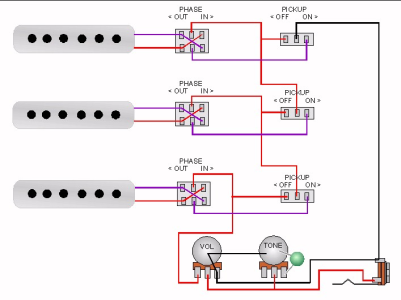
Thank you so much for this!
I was also thinking of adding the series/parallel switching. Superbeast520's post above referred to a circuit sent by "Maik Schrake of Germany" which sounds interesting, but it seems the treblebooster.com site is no longer extant. I guess it used one or two DPST mini toggles instead of the 4PDT - any ideas?
Thanks again for your kind help.
I was also thinking of adding the series/parallel switching. Superbeast520's post above referred to a circuit sent by "Maik Schrake of Germany" which sounds interesting, but it seems the treblebooster.com site is no longer extant. I guess it used one or two DPST mini toggles instead of the 4PDT - any ideas?
Thanks again for your kind help.
stratamania
Mythical Status
- Messages
- 12,276
@dram773 after reading some of the above posts, I think if you wanted to add a switch to the existing 6 switches a 4PDT could be used to switch between series or parallel for the pickups in one go.
I had a look and found a diagram from John Hewitt (guitarnuts.com) linked to below from the article at https://www.premierguitar.com/diy/mod-garage/red-special-wiring

Sadly, the original images of this thread from back in 2009 were originally hosted on Photobucket. A lot of those images have been lost due to when that company a few years back tried to hold people's content to ransom unless they paid a hefty fee. I think they changed their approach since then, but here we are.
A Fender S1 switch incorporated into a pot could also be used as that is 4PDT.
Now with these later posts it should be useful again to those interested.
I had a look and found a diagram from John Hewitt (guitarnuts.com) linked to below from the article at https://www.premierguitar.com/diy/mod-garage/red-special-wiring

Sadly, the original images of this thread from back in 2009 were originally hosted on Photobucket. A lot of those images have been lost due to when that company a few years back tried to hold people's content to ransom unless they paid a hefty fee. I think they changed their approach since then, but here we are.
A Fender S1 switch incorporated into a pot could also be used as that is 4PDT.
Now with these later posts it should be useful again to those interested.
Last edited:
Many thanks for another valuable contribution!
I'm working on an experimental studio guitar, using a routed-out strat style body with a decent neck. It's a bit complicated, involving a switchable sustainer driver and internal Roland GK3 synth access unit working together with an HSS arrangement. As the bridge humbucker can be coil split, I'm planning the BM on/off, in/out wiring for the (S)SS and would like to throw in the series/parallel option, too. I'm also planning individual volume controls for each pickup but no tone pots - tone shaping will be outboard.
If I ever get it finished and working, I'll let you know!
Meanwhile, thanks again for all your help.
I'm working on an experimental studio guitar, using a routed-out strat style body with a decent neck. It's a bit complicated, involving a switchable sustainer driver and internal Roland GK3 synth access unit working together with an HSS arrangement. As the bridge humbucker can be coil split, I'm planning the BM on/off, in/out wiring for the (S)SS and would like to throw in the series/parallel option, too. I'm also planning individual volume controls for each pickup but no tone pots - tone shaping will be outboard.
If I ever get it finished and working, I'll let you know!
Meanwhile, thanks again for all your help.
stratamania
Mythical Status
- Messages
- 12,276
After some thought over the long weekend, I think I'll go for a superswitch and 3 push-pull pots rather than individual switches. Theoretically, this can give me 85 sound combinations (although some might be redundant) and free up space for the sustainer/harmonic and synth PCBs. It won't offer all three pups on, but I doubt I'd use that combination. Will update in due course 
stratamania
Mythical Status
- Messages
- 12,276
After some thought over the long weekend, I think I'll go for a superswitch and 3 push-pull pots rather than individual switches. Theoretically, this can give me 85 sound combinations (although some might be redundant) and free up space for the sustainer/harmonic and synth PCBs. It won't offer all three pups on, but I doubt I'd use that combination. Will update in due course
Also check out the Freeway 5B5-01 blade switch which can give you ten positions, with that, you can perhaps get the combinations you want with less switches.
TBurst Std
Hero Member
- Messages
- 3,582
Owning a Brian May, I will share this:
Having the option of 3 pups on is good (I like it with the mid out of phase).
Using those slide switches in a live setting is not convenient. I’ve often thought about replacing them with toggles.
Having the option of 3 pups on is good (I like it with the mid out of phase).
Using those slide switches in a live setting is not convenient. I’ve often thought about replacing them with toggles.
Similar threads
- Replies
- 3
- Views
- 797
- Replies
- 4
- Views
- 854
- Replies
- 53
- Views
- 5K

